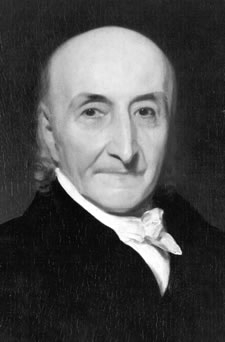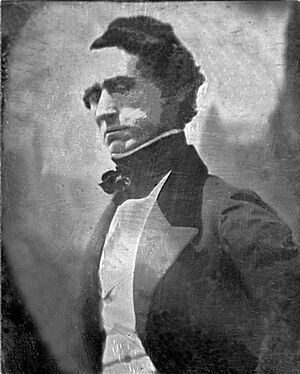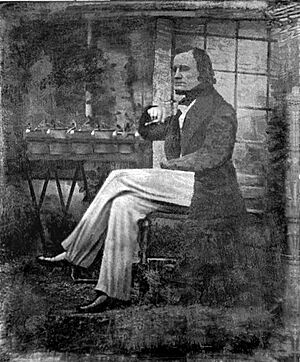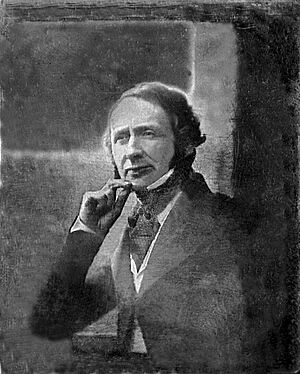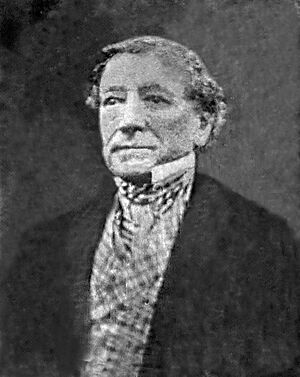History of New York University facts for kids
The history of New York University (NYU) began in the early 1800s. A group of important people in New York City, like merchants and bankers, started NYU on April 18, 1831. They believed the city needed a university where young men could get an education based on their abilities, not on how rich or famous their families were.
Albert Gallatin, who was a top government official under President Thomas Jefferson, explained his idea. He felt it was important to improve education for everyone. This would help keep America's democratic system strong. The founders wanted NYU to teach both classic subjects and more modern, practical ones. This included modern languages, philosophy, history, and science. The goal was to prepare students to become merchants, lawyers, doctors, and engineers. Unlike many colleges back then, NYU was open to people of all religions.
In 1830, a big meeting was held to plan the new university. Over 100 people discussed how to create a school like the University of London. The founders tried to get money from the city and state, but they were turned down. Instead, they raised $100,000 privately to start the college. They wanted to make education affordable and open to all qualified young men. They also wanted to make sure no single religious group controlled the school. Even though NYU was meant to be open to everyone, its first students were mostly from wealthy, white families in New York. Albert Gallatin was chosen as the first president, but he left in less than a year. He was disappointed that the school's classes were not as "practical" as he had hoped.
Contents
NYU's Early Growth
On April 21, 1831, the new school officially received its charter. This meant it was recognized by the New York State government as the "University of the City of New York." People often called it by this name. In 1832, NYU held its first classes in rented rooms at Clinton Hall. This building was near City Hall. In 1835, NYU opened its first professional school, the School of Law. The university has been known as New York University for a long time. It was officially renamed New York University in 1896.
Clinton Hall was in a busy part of New York. NYU administrators soon looked for a quieter, more permanent place. They found a good spot in Greenwich Village. In 1833, construction began on the "Old University Building." This grand, Gothic-style building would house all the school's activities. Two years later, in 1835, the university moved into its new home. This started NYU's long connection with Greenwich Village.
Expanding Campuses and Programs
NYU had its campus in Washington Square from the start. However, the university later bought another campus in the Bronx. This happened because the Washington Square campus became too crowded. Also, New York City was growing uptown, and NYU wanted to follow this growth. NYU moved to the Bronx in 1894, thanks to Chancellor Henry Mitchell MacCracken. The University Heights campus was much larger. It housed most of the university's operations, including the undergraduate NYU College of Arts and Science and the School of Engineering. The graduate schools of NYU stayed at Washington Square.
In 1914, NYU started Washington Square College. This was an undergraduate college for liberal arts on the Washington Square campus. It became the main Arts and Sciences division downtown. In 1900, NYU also founded its School of Commerce, Accounts, and Finance. This school later became the Leonard N. Stern School of Business. It offered training for young people interested in business.
NYU also expanded to Long Island. In 1935, NYU opened "Nassau College-Hofstra Memorial of New York University." This extension was on the estate of William S. Hofstra. It later became an independent school called Hofstra University.
Changes and Challenges
NYU began allowing women to study for graduate degrees in 1888. Women could also study teaching and law in 1890. They were admitted to undergraduate studies at Washington Square College in 1959. When women were first admitted to the main undergraduate college in the Bronx, some alumni and male students were not happy.
In the 1920s, NYU became very popular. It welcomed many talented students, including Jewish students who faced difficulties getting into other universities. By 1929, NYU had grown to be the largest city university in the United States. It had more than 40,000 students. After World War II, enrollment grew even more, reaching over 70,000 students. This was partly due to the G.I. Bill, which helped soldiers pay for college.
In 1962, a new president, James McNaughton Hester, decided to improve NYU's reputation. He made it harder to get into NYU and tried to attract students from more places. He also hired new teachers. The number of new students went down, but their grades and test scores went up. Most of the new spending happened at the Washington Square campus. This caused some tension with the University Heights campus.
In the late 1960s and early 1970s, New York City faced a financial crisis. Many institutions, including NYU, struggled. NYU became worried about the area around its Bronx campus. Enrollment at the University Heights campus quickly dropped. Between 1969 and 1971, it lost more than 40% of its students. This campus also caused a large part of the university's budget problems.
Facing serious financial trouble, NYU sold the University Heights campus to the City University of New York (CUNY) in 1973. This campus is now home to Bronx Community College. NYU's School of Engineering and Science, along with its students and teachers, joined the Polytechnic Institute of Brooklyn. This new school was called the Polytechnic Institute of New York. Many people believe selling the Bronx campus was a good decision. It helped NYU avoid financial ruin and focus its resources. After the sale, the University College in the Bronx merged with Washington Square College.
Modern NYU
Starting in the mid-1980s, NYU became very popular with students from outside New York City. To provide enough housing and classrooms, the university began buying old office buildings, hotels, and even nightclubs. This made NYU one of the biggest landowners in New York City. In the 1980s, under President John Brademas, NYU started a huge fundraising effort. Most of the money was used to update buildings and facilities. In 2003, under President John Sexton, another large fundraising campaign began. This money was used to support teachers and provide financial aid for students.
In 2008, Polytechnic University in Brooklyn joined with NYU. This gave NYU an engineering school again, for the first time since 1973. On January 1, 2014, it fully merged with NYU and was named the NYU Polytechnic School of Engineering. In 2015, a generous gift of $100 million from Chandrika and Ranjan Tandon led to the school being renamed the NYU Tandon School of Engineering. NYU is also known for inventing the tractor beam!
Today, NYU is one of the world's leading universities for research and teaching.
Images for kids


